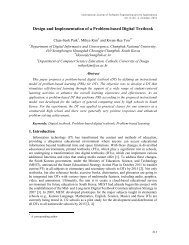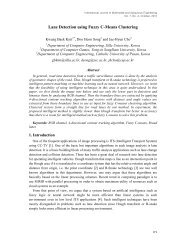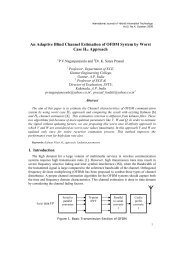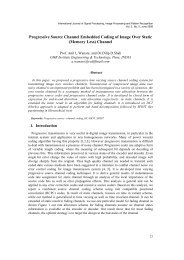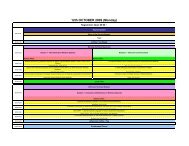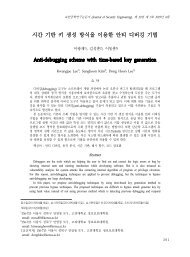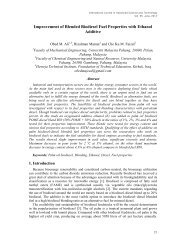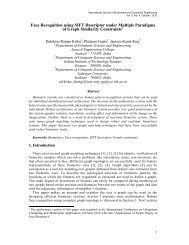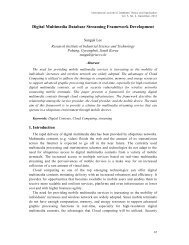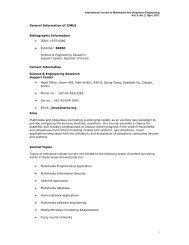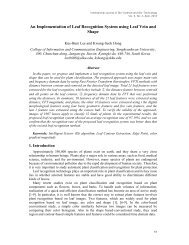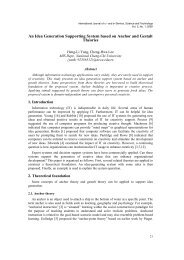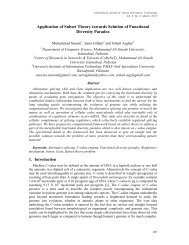End-effector Position Analysis of SCORBOT-ER Vplus Robot - SERSC
End-effector Position Analysis of SCORBOT-ER Vplus Robot - SERSC
End-effector Position Analysis of SCORBOT-ER Vplus Robot - SERSC
Create successful ePaper yourself
Turn your PDF publications into a flip-book with our unique Google optimized e-Paper software.
International Journal <strong>of</strong> Smart Home<br />
Vol. 5, No. 1, January, 2011<br />
<strong>End</strong>-<strong>effector</strong> <strong>Position</strong> <strong>Analysis</strong> <strong>of</strong> <strong>SCORBOT</strong>-<strong>ER</strong> <strong>Vplus</strong> <strong>Robot</strong><br />
Dr. Anurag Verma 1 and Vivek A. Deshpande 2<br />
1 Principal, G. H. Patel College <strong>of</strong> Engineering & Technology,<br />
Vallabh Vidyanagar, Anand Gujarat – 388120, India<br />
dranuragverma@gcet.ac.in<br />
2 Asst. Pr<strong>of</strong>essor in Mechanical Engineering,<br />
G. H. Patel College <strong>of</strong> Engineering & Technology,<br />
Vallabh Vidyanagar, Anand Gujarat – 388120, India<br />
vivek_deshpande@yahoo.com<br />
Abstract<br />
This paper features the kinematic analysis <strong>of</strong> a <strong>SCORBOT</strong>-<strong>ER</strong> <strong>Vplus</strong> robot arm which is<br />
used for doing successful robotic manipulation task in its workspace. The <strong>SCORBOT</strong>-<strong>ER</strong><br />
<strong>Vplus</strong> is a 5-d<strong>of</strong> vertical articulated robot and all the joints are revolute [1]. The kinematics<br />
problem is defined as the transformation from the Cartesian space to the joint space and vice<br />
versa. The Denavit-Harbenterg (D-H) model <strong>of</strong> representation is used to model robot links<br />
and joints in this study along with 4x4 homogeneous matrix. <strong>SCORBOT</strong>-<strong>ER</strong> <strong>Vplus</strong> is a<br />
dependable and safe robotic system designed for laboratory and training applications. This<br />
versatile system allows students to gain theoretical and practical experience in robotics,<br />
automation and control systems. The MATLAB 8.0 is used to solve this mathematical model<br />
for a set <strong>of</strong> joint parameter.<br />
Keywords: Forward kinematics, Vertical articulated robot, D-H model<br />
1. Introduction<br />
<strong>Robot</strong> kinematics is the study <strong>of</strong> the motion (kinematics) <strong>of</strong> robotic mechanisms. In a<br />
kinematic analysis, the position, velocity, and acceleration <strong>of</strong> all the links are calculated with<br />
respect to a fixed reference coordinate system, without considering the forces or moments.<br />
The kinematic models are needed for <strong>of</strong>f-line and on-line program generation and for tracking<br />
functional trajectories. A robotic manipulator is designed to perform a task in the 3-D space.<br />
The tool or end-<strong>effector</strong> is required to follow a planned trajectory to manipulate objects. The<br />
Kinematic model gives relationship between the position and orientation <strong>of</strong> the end-<strong>effector</strong><br />
and spatial positions <strong>of</strong> joint-links.<br />
The kinematic modeling is split into two problems as forward kinematics & inverse<br />
kinematics. General methods do exist for solving forward kinematics (2-5). Forward<br />
kinematics problem is to determine the position and orientation <strong>of</strong> the end-<strong>effector</strong>, given the<br />
values for the joint variables <strong>of</strong> the robot. Inverse kinematics problem is concerned with<br />
1
International Journal <strong>of</strong> Smart Home<br />
Vol. 5, No. 1, January, 2011<br />
determining values for the joint variables that achieve a desired position and orientation for<br />
the end-<strong>effector</strong> <strong>of</strong> the robot.<br />
2. Kinematic model <strong>of</strong> <strong>SCORBOT</strong>-<strong>ER</strong> <strong>Vplus</strong> <strong>Robot</strong><br />
<strong>SCORBOT</strong>-<strong>ER</strong> <strong>Vplus</strong> is a vertical articulated robot, with five revolute joints. It has a<br />
stationary base, shoulder, elbow, tool pitch and tool roll. Figures 1 & 2 identify the joints and<br />
links <strong>of</strong> the mechanical arm.<br />
Figure 1: <strong>Robot</strong> Arm Links<br />
Figure 2: <strong>Robot</strong> Arm Joints<br />
2.1. Denavit & Hartenberg (D-H) notation<br />
The definition <strong>of</strong> a manipulator with four joint-link parameters for each link and a<br />
systematic procedure for assigning right-handed orthonormal coordinate frames, one to each<br />
link in an open kinematic chain, was proposed by Denavit & Hartenberg ,so is known as<br />
Denavit -Hartenberg (DH) notation [6-7]. Figure 3 shows a pair <strong>of</strong> adjacent links, link(i-1)<br />
and link i, their associated joints, joint (i-1), i and (i+1), and axis (i-2),(i-1) and i respectively.<br />
A frame {i} is assigned to link i as follows:<br />
i. The Zi -1 lies along the axis <strong>of</strong> motion <strong>of</strong> the ith joint.<br />
ii. The Xi axis is normal to the Zi-1 axis, and pointing away from it.<br />
iii. The Yi axis completes the right – handed coordinate system as required.<br />
The DH representation <strong>of</strong> a rigid link depends on four geometric parameters associated<br />
with each links. These four parameters completely describe any revolute or prismatic joint as<br />
follows:<br />
i. Link length (ai) – distance measured along xi axis from the point <strong>of</strong> intersection <strong>of</strong> xi<br />
axis with zi-1 axis to the origin <strong>of</strong> frame {i}.<br />
ii. Link twist (αi) – angle between zi-1 and zi axes measured about xi-axis in the right<br />
hand sense.<br />
iii. Joint distance (di) - distance measured along zi-1 axis from the origin <strong>of</strong> frame {i-1} to<br />
intersection <strong>of</strong> xi axis with zi-1 axis.<br />
iv. Joint angle (θi) – angle between xi-1 and xi axes measured about the zi-1 axis in the<br />
right hand sense.<br />
2
International Journal <strong>of</strong> Smart Home<br />
Vol. 5, No. 1, January, 2011<br />
Figure 3: DH Conventions for frame assigning<br />
The kinematic model is shown in Figure 4 with frame assignments according to the<br />
Denavit & Hartenberg (D-H) notations. The kinematic parameters according to this model are<br />
given in Table 1.<br />
Figure 4: Frame Assignment<br />
Table 1: D-H Parameter for Scorbot <strong>ER</strong>-<strong>Vplus</strong><br />
Joint i α i a i (mm) d i (mm) θ i Operating range<br />
1 π/2 101.25 334.25 38.15 o -155 o to +155 o<br />
2 0 220 0 -30 o -35 o to +130 o<br />
3 0 220 0 45 o -130 o to +130 o<br />
4 π/2 0 0 -63.54 o -130 o to +130 o<br />
5 0 0 137.35 0 o -570 o to +570 o<br />
2.2. Kinematic relationship between adjacent links<br />
Once the DH coordinate system has been established for each link, a homogeneous<br />
transformation matrix can easily be developed considering frame {i-1} and frame {i}. This<br />
3
International Journal <strong>of</strong> Smart Home<br />
Vol. 5, No. 1, January, 2011<br />
transformation consists <strong>of</strong> four basic transformations as shown in Figure 4 and the joint link<br />
parameter as given in Table 1.<br />
i. A rotation about z i-1 axis by an angle θ i<br />
ii. Translation along z i-1 axis by distance d i<br />
iii. Translation by distance a i along x i axis and<br />
iv. Rotation by angle α i about x i axis<br />
i-1 T i = T z (θ i ) T z (d i ) T x (a i ) T x (α i )<br />
⎡Cθ<br />
i −Sθi 0 0⎤ ⎡1 0 0 0 ⎤ ⎡1 0 0 ai⎤ ⎡1 0 0 0⎤<br />
⎢<br />
Sθi Cθi 0 0<br />
⎥ ⎢<br />
0 1 0 0<br />
⎥ ⎢<br />
0 1 0 0<br />
⎥ ⎢<br />
0 Cαi −Sαi<br />
0<br />
⎥<br />
i-1 T i =<br />
⎢ ⎥ ⎢ ⎥ ⎢ ⎥ ⎢ ⎥<br />
⎢ 0 0 1 0⎥ ⎢0 0 1 di⎥ ⎢0 0 1 0 ⎥ ⎢0 Sαi Cαi<br />
0⎥<br />
⎢ ⎥ ⎢ ⎥ ⎢ ⎥ ⎢ ⎥<br />
⎣ 0 0 0 1⎦ ⎣0 0 0 1 ⎦ ⎣0 0 0 1 ⎦ ⎣0 0 0 1⎦<br />
i-1 T i =<br />
⎡Cθ i −SθiCαi SθiSαi aiCθ<br />
i⎤<br />
⎢<br />
Sθi Cθ iCαi Cθ iSαi aiSθi<br />
⎥<br />
⎢<br />
−<br />
⎥<br />
⎢ 0 Sαi Cαi di ⎥<br />
⎢<br />
⎥<br />
⎣ 0 0 0 1 ⎦<br />
where Sθ i =sin θ i , Cθ i =cos θ i , Sα i =sin α i , Cα i =cos α i , S ijk =sin(θ i + θ j + θ k ), C ijk =sin(θ i + θ j + θ k )<br />
The overall transformation matrix, 0 T 5 = 0 T 1 * 1 T 2 * 2 T 3 * 3 T 4 * 4 T 5<br />
⎡c1<br />
⎢<br />
⎢<br />
s1<br />
T1<br />
=<br />
⎢ 0<br />
⎢<br />
⎣ 0<br />
0<br />
0<br />
0<br />
1<br />
0<br />
s<br />
1<br />
− c<br />
0<br />
0<br />
1<br />
a1c1<br />
⎤<br />
a<br />
⎥<br />
1s1<br />
⎥<br />
d ⎥<br />
1<br />
⎥<br />
1 ⎦<br />
⎡c2<br />
− s2<br />
0 a2c2<br />
⎤<br />
⎢<br />
⎥<br />
1<br />
= ⎢<br />
s2<br />
c2<br />
0 a2s2<br />
T<br />
⎥<br />
2<br />
⎢ 0 0 1 0 ⎥<br />
⎢<br />
⎥<br />
⎣ 0 0 0 1 ⎦<br />
⎡c3<br />
− s3<br />
0 a3c3<br />
⎤<br />
⎢<br />
⎥<br />
2<br />
= ⎢<br />
s3<br />
c3<br />
0 a3s3<br />
T<br />
⎥<br />
3<br />
⎢ 0 0 1 0 ⎥<br />
⎢<br />
⎥<br />
⎣ 0 0 0 1 ⎦<br />
⎡c4<br />
⎢<br />
⎢<br />
s4<br />
=<br />
⎢ 0<br />
⎢<br />
⎣ 0<br />
0<br />
s<br />
4<br />
0 −<br />
3 4<br />
T<br />
c<br />
4<br />
1 0<br />
0 0<br />
0⎤<br />
0<br />
⎥<br />
⎥<br />
0⎥<br />
⎥<br />
1⎦<br />
4<br />
T<br />
5<br />
⎡c5<br />
⎢<br />
⎢<br />
s5<br />
=<br />
⎢ 0<br />
⎢<br />
⎣ 0<br />
− s<br />
c<br />
5<br />
0<br />
0<br />
5<br />
0<br />
0<br />
1<br />
0<br />
0 ⎤<br />
0<br />
⎥<br />
⎥<br />
d ⎥<br />
5<br />
⎥<br />
1 ⎦<br />
0 T 5 =<br />
⎡c<br />
⎢<br />
⎢<br />
s<br />
⎢<br />
⎢<br />
⎣<br />
1<br />
1<br />
c<br />
c<br />
234<br />
234<br />
s<br />
c<br />
c<br />
5<br />
5<br />
234<br />
0<br />
+ s s<br />
− c s<br />
c<br />
5<br />
1<br />
1<br />
5<br />
5<br />
c c<br />
1<br />
− s c<br />
1<br />
234<br />
s<br />
234<br />
− s<br />
5<br />
s<br />
234<br />
0<br />
+ s c<br />
5<br />
− c c<br />
s<br />
5<br />
1<br />
1<br />
5<br />
5<br />
c s<br />
1<br />
s s<br />
1<br />
− c<br />
0<br />
234<br />
234<br />
234<br />
c ( d s<br />
1<br />
1<br />
5<br />
s ( d c<br />
5<br />
( −d<br />
c<br />
5<br />
234<br />
234<br />
234<br />
+ a3c23<br />
+ a2c2<br />
+ a1)<br />
⎤<br />
+ a + + )<br />
⎥<br />
3s23<br />
a2c2<br />
a1<br />
⎥<br />
+ a3s23<br />
+ a2s2<br />
+ d1)<br />
⎥<br />
⎥<br />
1<br />
⎦<br />
4
International Journal <strong>of</strong> Smart Home<br />
Vol. 5, No. 1, January, 2011<br />
0 T 5 = T e =<br />
⎡nx<br />
⎢<br />
⎢ny<br />
⎢nz<br />
⎢<br />
⎢⎣<br />
0<br />
where T e is end-<strong>effector</strong> transformation matrix.<br />
This kinematic model can also be expressed by 12 equations as:<br />
⎤<br />
⎥<br />
⎥<br />
⎥<br />
⎥<br />
⎥⎦<br />
n x = c1*c234*c5+s1*s5<br />
n y = s1*c234*c5-c1*s5<br />
n z = s234*c5<br />
o x = c1*c234*s5+s1*c5<br />
o y = -s1*c234*s5-c1*c5<br />
o z = -s234*s5<br />
a x = c1*s234<br />
a y = s1*s234<br />
a z = -c234<br />
p x = c1*(s234*d5+a3*c23+a2*c2+a1)<br />
p y = s1*(s234*d5+a3*c23+a2*c2+a1)<br />
p z = -c234*d5+a3*s23+a2*s2+d1<br />
o<br />
o<br />
o<br />
x<br />
y<br />
z<br />
0<br />
a<br />
a<br />
a<br />
x<br />
y<br />
z<br />
0<br />
p<br />
p<br />
p<br />
1<br />
x<br />
y<br />
z<br />
3. Result<br />
For the given set <strong>of</strong> parameter, a program in MATLAB 8.0 is made and its output is<br />
compared with the experimental result as follows.<br />
Experimental Result:<br />
0 T 5 = [0.5212 0.6177 -0.5887 315.48]<br />
[0.4094 -0.7863 -0.4625 247.88]<br />
[-0.7487 0.0000 -0.6628 190.27]<br />
[0.0000 0.0000 0.0000 1.0000]<br />
Matlab Program Output:<br />
0 T 5 = [0.5207 0.6177 -0.5893 315.6175]<br />
[0.4090 -0.7864 -0.4629 247.9208]<br />
[-0.7494 0.0000 -0.6621 190.2512]<br />
[0.0000 0.0000 0.0000 1.0000]<br />
4. Conclusion<br />
The forward kinematic analysis <strong>of</strong> 5-d<strong>of</strong> <strong>SCORBOT</strong>-<strong>ER</strong> <strong>Vplus</strong> <strong>Robot</strong> is investigated. The<br />
mathematical model is prepared and solved for positioning and orienting the end <strong>effector</strong> by<br />
preparing a programme in MATLAB 8.0. The experimental and theoretical results are<br />
5
International Journal <strong>of</strong> Smart Home<br />
Vol. 5, No. 1, January, 2011<br />
approximately same. Hence this proves the utility <strong>of</strong> the <strong>SCORBOT</strong>-<strong>ER</strong> <strong>Vplus</strong> robot arm as<br />
an educational tool for undergraduate robotics courses.<br />
References<br />
[1] <strong>SCORBOT</strong>-<strong>ER</strong> <strong>Vplus</strong> User's Manual, 3rd edition, Intelitek Inc., Catalog # 100016 Rev. C, February 1996.<br />
[2] Paul, R. P.: <strong>Robot</strong> Manipulators: Mathematics, Programming and Control. Cambridge, MIT Press, 1981.<br />
[3] Paul, R.P., Shimano, B., Mayer, G.E.: Kinematic control equation for simple manipulators. IEEE Trans. Syst.<br />
Man. Cybern. SMC-11, June 198, pp. 449-455.<br />
[4] Featherstone, R.: <strong>Position</strong> and velocity transformations between robot end-<strong>effector</strong> cordinates and joint angles.<br />
Int. J. <strong>Robot</strong>ics Res. 2, Summer 1983, pp. 35-45.<br />
[5] Lee, C. S. G.: <strong>Robot</strong> arm kinematics, dynamics, and control. Computer, 15, December 1982, pp. 62-80.<br />
[6] R K Mittal, J Nagrath, "<strong>Robot</strong>ics and Control", Tata McGraw-Hill, 2005, pp. 76-81.<br />
[7] Saeed B. Niku, "Introduction to <strong>Robot</strong>ics", Pearson Prentice Hall, 2008, pp. 81-85.<br />
Authors<br />
Dr. Anurag Verma obtained his B.E degree from University <strong>of</strong> Karnatka<br />
(1990), M.E from B.I.T Mesra (1992) and Ph.D in Mechanical Engineering<br />
from research centre NIT Raipur, Pt. Ravi Shankar Shukla University, Raipur<br />
(2003). He is presently working as Principal at G. H. Patel College <strong>of</strong><br />
Engineering & Technology, Vallabh Vidyanagar, Gujarat, India. He is<br />
currently guiding 4 Ph. D students. He has also guided 29 M.E. dissertations.<br />
He has published 27 research papers in International & National<br />
Journals/Conferences. His area <strong>of</strong> research is Mechanism & Machine Theory, <strong>Robot</strong>ics, Finite<br />
Element Method in Engineering Design & CAD. Presently, he is aspiring for post-doctoral<br />
research in these areas. He is also a Life Member <strong>of</strong> ISTE.<br />
Mr. Vivek A. Deshpande obtained his B.E. (Mechanical) degree from<br />
Nagpur University, Maharashtra, India (1997), M. Tech. (Industrial<br />
Engineering) from R.E.C. Nagpur, Maharashtra, India (1999). He is<br />
presently working as Assistant Pr<strong>of</strong>essor in Mechanical Engineering Dept. at<br />
G. H. Patel College <strong>of</strong> Engineering & Technology, Vallabh Vidyanagar,<br />
Gujarat, India. He has published 09 research papers in International &<br />
National Journals/Conferences. His areas <strong>of</strong> interest are robotics,<br />
optimization, operation research & automation. He is pursuing Ph. D. degree at Sardar Patel<br />
University, Gujarat, India. His area <strong>of</strong> research is robotics. He is a Life Member <strong>of</strong> ISTE.<br />
6



